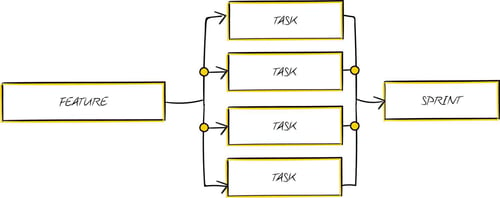Table of Contents
Before you embark on building your mobile application, it is important to consider the project management approach your prospective app developers will use. This is often an overlooked criterium for choosing the right partner, but affects the trajectory of your project massively. In this article, we make the case that the Agile approach to mobile app development is the only way to go.
What is affected when you choose the wrong approach?
Traditionally, project management revolves around the rigorous planning of every step from beginning to end. However, for app development, this ‘fixed scope’ approach is an unrealistic expectation. It is impossible to set out the roadmap for the project in its entirety since there are many points throughout the process where project pivots may occur.
Feedback from users may change the direction of the mobile application
Releasing a minimal viable product (MVP) into the marketplace should be the first place you start. Eric Ries defines it as a “version of a new product which allows a team to collect the maximum amount of validated learning about customers with the least effort.” In the context of app development, this means releasing an app with one or two features that are essential.
After this first release, rigorous feedback will be collected from users. You may choose to do this with an open or closed beta release, using app analytics and user interviews to gather the necessary feedback. It may be the case that you will need to completely change your original course of action or your feature priority will change.
After this first release, rigorous feedback will be collected from users. You may choose to do this with an open or closed beta release, using app analytics and user interviews to gather the necessary feedback. It may be the case that you will need to completely change your original course of action or your feature priority will change.
More money and time for additional features
Under a traditional project management model, changing the original scope by moving the app in a different direction or adding new features will need to be quoted for. This means that you will incur an additional cost that wasn’t anticipated. In addition, working from this fixed approach also means that you will have to extend the initial timeline set out since your app developers will need to reshuffle all the original plans to make room for the new features that need to be implemented.
Undoubtedly, time and money are two of the most valuable assets that you have, and there is no way you can afford to waste any of it. By spending more time, you are missing out on the key market advantage of being early. Diverting money to the new costs that have crept up, means compromising on other important business activities.
How is Agile Development Different?
The agile approach to project management allows you to have the flexibility to change the project’s course, whilst still retaining a well-organised way to ensure the project moves along swiftly. Choosing an app developer who works in this way will allow you to avoid the pitfalls that may be encountered with app developers who operate under the notion of a ‘fixed scope’.
The agile process is focused on constant iteration and responding quickly to changes. The basic premise of agile development surrounds the idea of ‘sprints’. This divides the project into manageable parts, generally lasting two weeks. These sprints consist of tasks that are planned for the particular sprint period. These tasks relate to some particular features of the app.

Traditional project management works in a way where all features in a particular phase of development are built, then tested and then feedback is taken into account. Under the agile method of development, each feature is built, tested and reviewed iteratively. After every sprint, the team analyses the progress that has been made and can re-evaluate and re-adjust for the next sprint.
Why the flexibility of Agile development is awesome
It’s not hard to see why the agile development model is perfect for building mobile applications. Developing feature by feature opens up ample opportunity to create feedback loops, which can be factored into future sprints. Prioritisation occurs at every stage of the project – reshuffling tasks depending on what has been derived from client and customer reviews.
This flexibility means that there is a lesser chance that you’ll encounter unexpected hikes in the costs and time frames of the project. In the technology space, trends and customer behaviour shift incredibly quickly. You and your app developers need to be able to respond to this environment just as fast. The agile methodology facilitates this, without wasting time or capital. When it comes to app development, there isn’t any other way to go except agile.

Laxmi Hari drives Agile transformation, coaching teams to adopt Agile methodologies, instill values, and foster a culture of continuous improvement.
Read more Articles by this Author
